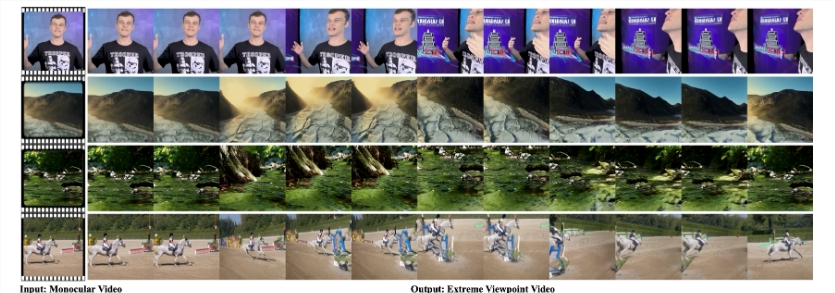EX-4D (Extreme Viewpoint4D Video Generation) technology, developed by the research team tau-yihouxiang, is a revolutionary video generation innovation that has attracted widespread attention worldwide. This technology aims to convert monocular videos into controllable 4D experiences, especially demonstrating excellent performance under extreme camera angles.
The core of EX-4D technology lies in its unique "depth watertight mesh" construction method. This novel geometric representation can effectively model visible and occluded areas, generating high-quality videos within a wide angle range of -90° to 90°. This breakthrough lays the foundation for applications in multiple fields such as gaming, film production, virtual reality (VR), and augmented reality (AR).
Different from traditional video generation methods, EX-4D does not require expensive multi-view datasets. It uses an innovative masking strategy, significantly reducing data acquisition costs. In addition, the lightweight architecture used by this technology means that its training parameters are only 1% of those of a 14B video diffusion backbone, greatly improving the model's training efficiency.
In user studies, 70.7% of participants preferred the video effects generated by EX-4D. Its performance in physical consistency and extreme perspective quality clearly outperforms existing baseline methods. This fully demonstrates the significant advantages of EX-4D in handling extreme camera angles, indicating that the future of video content creation will be more vivid and expressive.

EX-4D has broad application prospects. It can be used not only to create immersive game videos, generate new camera angles for film post-production, but also to provide dynamic camera movements for social media content creation. The release of this technology marks another major leap in the field of video generation.
However, EX-4D also faces some challenges, including dependence on the quality of monocular depth estimation, computational costs, and the handling of reflective and transparent materials. The research team stated that they will focus on optimizing real-time inference and supporting higher resolution video generation in the future, further promoting the development of this technology.
The implementation of EX-4D not only injects new momentum into the advancement of video generation technology, but also opens up broad prospects for applications in related industries. With the continuous improvement of this technology, the future of digital content creation will be more diverse and innovative.










